May 8, 2018
What is a Water Surge like on the Bay of Green Bay?
A water surge is the result of strong winds usually coming from the north-northeast. These winds cause the water to move south along the Door County Penninsula into the Fox River in Green Bay. The water eventually moves against the DePere Dam on the south end.
As the water accumulates at the dam it begins to back up into the Bay raising the water level. This can amount to inches or several feet depending on the strength and duration of the winds. An example would be on Aug. 4, 2017.
On that date, the Bay of Green Bay experienced a storm “surge” of at least 3 – 4 feet.
This particular “surge” raised the level of the Bay throughout the early morning hours. Most people were not even aware of what was happening. As a result, they did not have an opportunity to do anything to protect their docks or boats. The wind velocity continued to rise throughout the day.
Those winds caused waves of 4’- 9’ on top of the water surge. The damages to shorelines, docks. boats and lifts were considerable.
People reported waves bouncing their boat on their lifts for hours. Many could only watch as the waves swept their dock decking away. Others watched helplessly as their boats were swept off their lifts. (You don’t want that to happen with weak or damaged cables.)
There was considerable damage to boats, docks, decking and boat lifts. Recovery efforts took several weeks, and repairs are ongoing.
What can you learn from this storm?
Check with your Insurance Company now.
A final point, check with your insurance company to see if you have coverage in the event your boat is swept off the lift. What about your boat lift? Is it covered for storm damage?
This may require a “rider” to get coverage. Many insurance companies cover wind damage but not wave damage. It’s all in how you word the claim. Your agent should be able to assist you to make sure you have the proper coverage.
Also, check for boat and/or lift salvage coverage (a worst case scenario.)
Where is Pier & Waterfront Solutions located?
PWS is located at 7325 St. Hwy 42/57. That’s 1 mile North of County MM (Hwy 42) and 3 miles South of Sturgeon Bay. Look for the Idlewild Road intersection.
Our staff is ready to assist you year round.
Don’t forget – Give us a call If you want to see an issue discussed on our site.
Call Jerry at 920-493-4404 or Email Jerry@wisconsinpws.com for more information.
May 29, 2018
What is the right Boat lift for Me? – Part 1
Purchasing a new boat lift is a very confusing time You have a lot to consider before making your decision. This article will help you make your lift selection easier.
Where will you be using the boat lift?
One factor in your lift selection process is its suitability for the body of water you will be using it on. Will you be on a large bay or lake where waves can be strong? Will it be a river or small lake with minimal wave action?
In NE Wisconsin, Green Bay and Lake Winnebago present unique problems for boaters. These two bodies of water have significant fluctuations in water depth and wave action. Wave action of 3 or more feet added to increasing water depth during a surge will cause significant problems for boaters.
When these two factors combine, you will want a lift that raises high enough to keep your investment from being damaged.
Consider Frame Construction
You need durable frame construction to withstand the boat weight and pressures from the moving water.

ShoreMaster Vertical Boat Lift with welded side frames
Are the side frames all welded construction? Are the side frames simply bolted together? Most brands use bolts everywhere, so shipping is less expensive. This results in frame movement over time. Movement results in elongated holes and a weaker frame structure.
What are the Boat Lift Frame Materials?
The most popular boat lifts in N.E. Wisconsin has aluminum frames and stainless steel cables.
What is the Warranty of the frame material?
Boat lifts come with a 1 or 2-year factory structural warranty. Some have a five year, and a few even have a 10-year warranty.
ShoreMaster boat lifts carry a full 15-year structural warranty. This 15-year warranty is the result of the all-welded side frames. Bolts are only used to assemble the side frames to the cross members.
Most brands use bolts everywhere, so shipping is less expensive, but this results in frame movement over time. Movement results in elongated holes and a weaker frame structure.
Your boat deserves the extra protection and strength of a ShoreMaster boat lift.
What type of cable do they use?
Boat lifts today have either galvanized, stainless steel or a combination of both. Stainless steel cables last as much as 2 – 4X longer than galvanized cable. Stainless steel cable is not as strong as galvanized but the manufacturers increase the cable and winch diameters to compensate.
There are limits to the diameter of the cabling used. The winch drum diameter limits the cable diameter. A thick cable wrapping around a small drum flexes the cable unnaturally resulting in premature cable failure.
Boat length, width, and weight?
Consider not only the length, width, and weight of the boat you have now but also the possibility of a larger boat in the future. This may not be the deciding factor in your boat lift decision, but don’t ignore it altogether. It can be the difference between:
- Buying a new boat OR
- Buying a new boat AND a new boat lift.
Manual or Electric operation
Do you want to raise your boat by using the hand wheel or use a motor to do all the work for you? Nature powers most lift motors through a D.C. motor and battery setup.
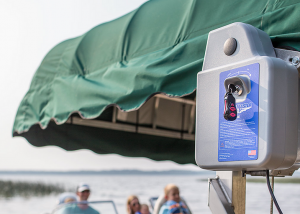
ShoreMaster Boat Lift with a DC Motor
A.C. versions, while available, require 120 V power at the boat site and need more care to prevent electrical shock.
Resale values
While cantilever boat lifts generally cost less than vertical lifts initially, consider the resale value if you decide to get a larger boat which requires a new lift. Cantilever lifts typically have less resale value because they can be used in fewer applications. Vertical lifts allow you to function in shallower water and raise your boat higher. For this reason, they hold their value more than a cantilever boat lift.
See Part 2 for additional information
Where can you find the solution to any boatlift situation?
At Pier & Waterfront Solutions, of course!
PWS is located at 7325 St. Hwy 42/57. That’s 1 mile North of County MM (Hwy 42) and 3 miles South of Sturgeon Bay. Look for the Idlewild Road intersection.
Our staff is ready to assist year round.
Call If you want to see an issue discussed on our site.
Call Jerry at 920-493-4404 or Email Jerry@wisconsinpws.com with any questions.
Jan 29, 2018
An ice Shove by any name …
Ice Shove, Ice Heave, Ice Surge, or Ice Tsunami, no matter what you call it, they all refer to the same natural phenomena.
First, you need to understand how a pressure ridge forms so please follow this link to this article: https://wisconsinpws.com/ice-pressure-ridge/
The pressure ridge is the usual predecessor of an ice shove.
Having read the article, we need to talk very briefly about the terminology of a pressure ridge.
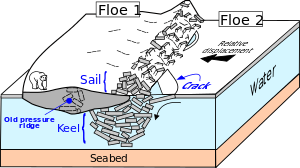
Sample Pressure Ridge
From the previous article, you can see the “rubble” forming the “Keel” of the pressure ridge. After the Keel forms the “Sail” forms above the surface of the ice. When the next strong wind comes along the “sail” will begin pushing against the shore ice. Eventually, some of it will begin to climb over the shore ice and form an ice shove.
When do Ice shoves typically occur?
Ice shoves normally happen during a spell of warmer weather. However, the shove may happen anytime the ice is weakened and then exposed to strong winds.
A shove is more likely to occur the longer the ice is exposed to the winds. The most common time of the year to see this phenomenon is late February and into March although January is not unheard of if a thaw occurs.
The shove occurs when strong winds rapidly push free-floating ice towards or along the shore. Strong winds over time drive areas of ice onshore. As these moving masses of ice travel towards the shoreline, they begin piling up when they encounter resistance from the shoreline or other obstacles. The resulting shove can reach heights of up to 50 feet.

Ice Shove on a Road
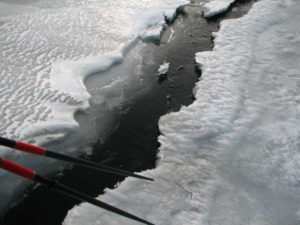
Ice crack before forming an ice pressure ridge
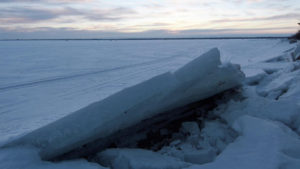
An ice shove beginning
What will an ice shove do to my property?
An ice shove has tremendous power and have been known to push houses off their foundations and uproot large trees and crush seawalls.
Shoreline barriers like trees, seawalls and shallow cliffs do not present any challenge to an ice shove. The ice simply piles up until it flows over the object or simply crushes it. The shove could continue on its journey as long as the winds continue. This depends on the force of the wind and the strength of the ice. One or two properties may be affected while the adjoining properties see no movement at all.
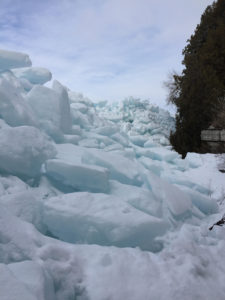
Ice Shove
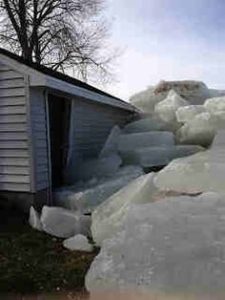
Ice Shove damaging a building
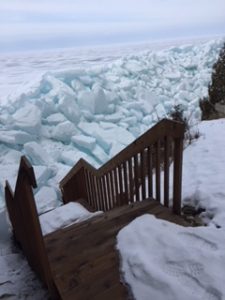
Door County Ice Shove
How do I protect my property?
There is only one thing that you can do – move your waterfront equipment far enough away that the ice normally will not get to it. In doubt? Watch what your neighbors do in Fall. If they have been there for any length of time they know how far back to go to protect their equipment in a normal year. Our crews remove equipment in Fall and have a good idea where it has to go also.
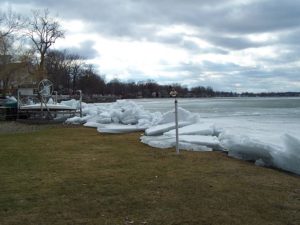
Ice Shove
What does Pier and Waterfront Solutions do to protect equipment?
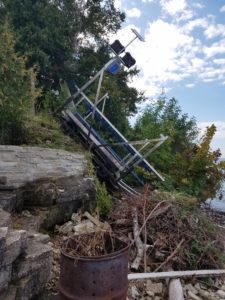
Lift Removal to escape an ice shove
With little or no shoreline, here’s an example of what PWS does to prevent damage to your equipment. The lift and dock had to be raised to the top of a ledge to avoid damage.
How big are Ice Shoves?
Ice Shoves sometimes affect a small area of shoreline all the way up to vast distances. This ice shove affected just one property while the neighbors had no damage.
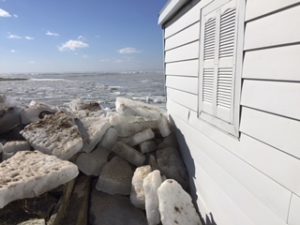
Door County Ice Shove -2017
For more information check this video to see an actual ice shove in action: https://www.youtube.com/watch?v=Pf5pWz7uRt4
Reminder
Pier & Waterfront Solutions specializes in ShoreMaster docks, lifts, and accessories both residential and commercial. We service the rest.
PWS is located in the center of Door County at 7325 St Hwy 57. Located 1 mile North of County MM (Hwy 42) and South of Sturgeon Bay at the intersection of Idlewild Road. Our staff is ready to help you anytime.
Want us to address a dock or boat lift topic for you? Feel free to give us a call.
Call Jerry at 920-493-4404 or email him at Jerry@wisconsinpws.com for more information.
Sep 18, 2021
7325 State - Highway 57, Sturgeon Bay, WI 54235 | Hours: Mon–Fri: 8am-4pm • Saturday: By appointment • Sunday: Closed 7325 State - Highway 57, Sturgeon Bay, WI 54235Hours: Mon–Fri: 8am-4pmSaturday: By appointment • Sunday: Closed Sales:...
Jan 5, 2021
Boat Lift Styles
In Wisconsin waters, there are (5) different boat lift styles generally used. The (5) styles include:
- Cantilever,
- Vertical,
- Hydraulic,
- Floating, and
- Elevator boat lifts.
Different conditions require different boat lifts.
Cantilever Lift
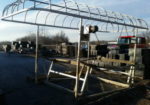
Cantilever Boat Lift Style
If you are on an inland lake or river where the water depth does not fluctuate more than 12″ throughout the boating season and wave action does not exceed 6″, a cantilever lift is generally suitable for you.
Cantilever lifts requires about 12″ of water plus the draft of your boat to operate. The lifting rack requires that depth of water due to the shape of the frames.
At first glance, that seems deep enough for most boats, but you still have to allow enough water above the rack to float your boat.
The real limitation of a cantilever lift is the total lifting height. If a river rises, especially after a heavy rainstorm, a boat can easily float off the lift. The boat is not up high enough to prevent the water from washing it away. Who knows how far it will travel before it hits something?
The normal lifting range is between 40″ and 48″. Remember, the rack starts at 12″ plus the draft of your boat, so you are usually less than 12″ above the water at its highest point.
Vertical Lift
On any large body of water, a vertical lift is the recommended lift for most people. Vertical lifts do a better job of protecting your boat from waves.
Some vertical lifts require about 6″-10″ of water plus the draft of the boat. As an example, ShoreMaster vertical boat lifts require only 6″ of water (plus the draft of your boat). Given the same conditions, you have already gained 6″ with this one feature alone.
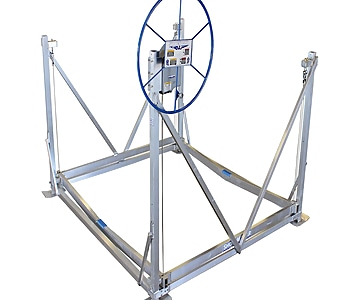
Vertical Boat Lift Style
Now, add the total lifting height of 66″ for a ShoreMaster vertical lift, and you gained a minimum of 18 or more inches of protection vs. a cantilever lift.
Your most significant protection comes from the lifting height. Don’t forget about the strength of the lift frame and the gauge of the material used. ONLY the ShoreMaster boat lift has welded side frames with heavy-duty square or rectangular frames for more strength.
Other brands require several packages of bolts and nuts to assemble the frames. Eventually, the holes for the bolts enlarge, and the frames begin to sway. The solid welded frame is a real advantage at this time. A minimal number of bolts are needed.
Can a lift raise a boat TOO high?
Strange as it may seem, it is possible to go too high. How? When the frames are not strong enough to handle the leverage of the weight from the boat.
At least one brand does lift higher than a ShoreMaster lift, but they failed to use welded frames for the additional strength it needs.
If you can imagine the forces acting against the frames in a storm when you have thousands of pounds suspended in the air with only simple bolts to hold them together. The higher the boat is, the greater the leverage on the frames.
Their leg wall thickness is not heavy enough to handle the forces acting against it. Green Bay produces more than 4′ high waves, and the waves frequently strike against the bottom of a boat, adding to the leverage problems.
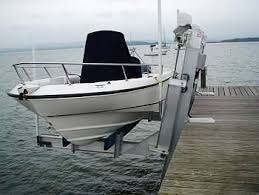
Elevator Boat Lift Style
Elevator Lift
Used with permanent pier installations, Elevator Lifts are a great combination. They raise the boat from the side, making access to the lift very easy.
Narrow channels and areas experiencing large fluctuations in water depth or hurricanes require elevator lifts.
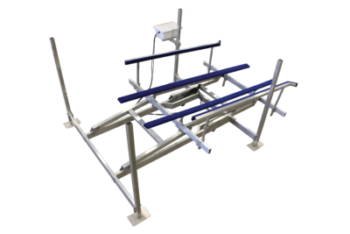
Hydraulic Boat Lifts Style
Hydraulic Boat Lift
A hydraulic lift generally lifts the highest – up to 6′ high in some cases. This height, along with the wide stance of the base, gives excellent protection for your boat. The hydraulic lift handles high waves and water surges during storms also.
These D.C. operated units are:
- Quiet:
- Smooth operating;
- Solar-powered;
- Wireless remote-controlled (There are no wheels to contend with.)
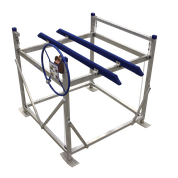
Vertical PWC Boat Lift
Vertical PWC Lift
Jet Ski lifts come in 3 styles: Vertical, Cantilever, and Floating.
The vertical PWC lifts allow you to get into shallow water and raise your boat higher than the cantilever type. They operate in the same fashion as a standard vertical boat lift and provide more protection for your PWC.
The PWC cantilever lift works fine on small lakes and rivers that do not fluctuate in depth or have high waves.
SHOREPORT
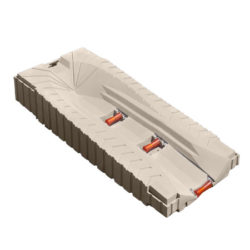
ShorePort PWC Boat Lift Style
The floating lifts (ShorePort) are excellent on rivers that fluctuate a lot in depth or inland lakes. These are very simple to use and require very little water to operate. The floating lift has no maintenance and you simply drive up onto the floating unit. No wheel cranking involved.
Wave action above 12” is not recommended for this type of “lift”. Combine a floating dock with the PWC floating lift and you have the perfect combination for a lake or river that fluctuates during the season but does not have large wave action.
Caution – when using any PWC lift – If you have a sand or small rock bottom near the shore use caution when approaching the lift. Sand and small stones can be sucked into the intake and destroy your motor.
For more information see also: www.wisconsinpws.com/boat-lift-size-correct-one/ and https://wisconsinpws.com/boat-lift-selection/
Where is Pier & Waterfront Solutions?
Located at 7325 St. Hwy 57, it’s 3 miles south of Sturgeon Bay and 1 mile PAST the intersection of Cty MM (heading north). Look on the right at the intersection of Idlewild Road and Hwy 57.
ARE WE OPEN?
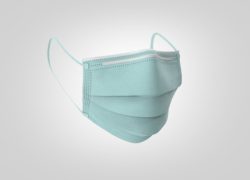
Please use face masks
Pier & Waterfront Solutions remains “open” year-round.
The virus continues to spread. PWS is conducting as much business as possible by email, text, or phone.
Site visits continue as usual. When in-person contacts are necessary, we follow “social distancing” guidelines as closely as possible.
Our display yard is OPEN 24-7
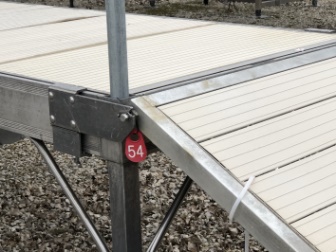
Red Tag
PWS‘s display yard is always open for you to examine at your leisure. All displays available for sale have a numbered, red tag on them. If you want more information or pricing, please reference that number when you inquire.
We provide estimates and quotes by email to make the process faster, safer, and paperless.
What can YOU do?
Please conduct as much business as possible via emails, messaging, and phones. When you see our staff and crews on-site, please practice “social distancing.”
Call, message, or email us with any questions.
Thank you for allowing us to work with you safely.
Let’s all stay safe!

























